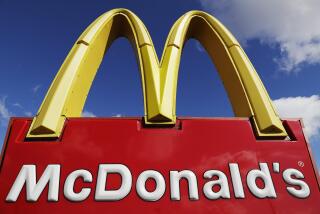Call Them Supermarketers
The hungry office worker heading home after a hard day has a difficult choice: Will it be McDonald’s or Burger King (again)? A pizza joint? That little sushi bar on the corner?
More and more, consumers are heading not to the nearest fast-food outlet or restaurant but to the neighborhood Safeway and Ralphs, which offer not only convenient dinner fare--from frozen dinners slated for the microwave to prepared salads, chicken and pizza--but also the makings for an evening of entertainment in the form of videocassette rentals, books and other products.
That’s a finding of Frank Panyko of the Food Institute, a trade group in Fair Lawn, N.J., which for three years has released annual studies on how Americans spend their food dollars.
“On a nationwide basis, we’ve seen over the past year and a half more growth on the part of supermarkets in real terms than on the part of the eating-out business,” Panyko (pronounced Panko) said recently. “In states like California, where you’ve got a lot of large super-size markets that are selling a large variety of non-foods, your supermarket operator is getting more of the consumer’s dollar.”
Stores such as the Ralphs Giants, which are opening over the next several weeks in the Southland, represent an attempt by supermarkets and convenience stores “to take dollars away from the eating-out business,” Panyko said. Many supermarkets now feature bakery and deli sections, video rentals, pharmacies and other departments geared to one-stop shoppers.
Panyko’s surveys, compiled for about 2,800 members worldwide, indicate that supermarkets’ efforts to entice consumers are paying off in two ways: Shoppers are buying more premium-quality products, such as fancy ice creams and pasta salads, and are getting a more exotic mix of foods. This, in turn, reduces the amount of disposable income available for eating out.
Based on rough estimates for the first half of 1986, Panyko said grocery store sales in the Pacific states (California, Washington, Oregon, Alaska and Hawaii) are growing at a 2% rate after negligible growth last year. At eating and drinking establishments, however, the institute “still sees fairly flat business.” When figures are tallied for the full year, Panyko said, he expects the trend to be even more evident.
The shift was not reflected in statistics for 1985, Panyko noted. According to the institute’s analysis of Census Bureau figures, the Pacific states registered the smallest gain among U.S. regions in food-store spending in 1985, with a $1,230 per-capita payout, up $6, or 0.5%, from 1984. Overall, Americans spent $1,182 per capita at U.S. food stores last year, an increase of 3.4%.
Consumers in the Pacific states ranked second behind New Englanders in the amount spent at eating and drinking places in 1985, with expenditures increasing by only $4 per capita, or 0.6% above 1984, to $676. Per-capita spending in the Northeast rose 11.8% to $739.
Nationwide, Americans spent $549 each, an increase of 4.2%.
In terms of total retail spending for food in 1985, Western consumers accounted for $43 billion of the $282 billion spent in food stores and almost $24 billion of the $131 billion spent at restaurants.
More to Read
Inside the business of entertainment
The Wide Shot brings you news, analysis and insights on everything from streaming wars to production — and what it all means for the future.
You may occasionally receive promotional content from the Los Angeles Times.











